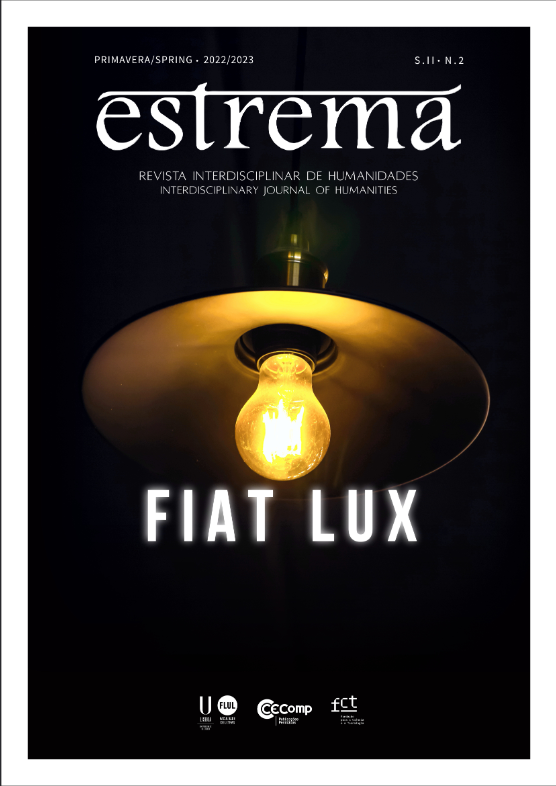Iris Murdoch: das sombras à luz
DOI:
https://doi.org/10.51427/com.est.2023.02.02.0004Keywords:
Iris Murdoch, Attention, The Bell, A Severed Head, LightAbstract
In this essay, I argue that the image of light is a very significant one in Iris Murdoch’s work both philosophical and literary, and I explore its potentialities as well as its limitations. I establish a link between two novels by Iris Murdoch and her philosophical ideas, by making reference to her philosophical work as a whole. The Bell (1958) and A Severed Head (1961) respectively represent, in my reading, a transition from the shadows to light, with the second novel reproducing in a very direct way Plato's allegory of the cave. In this transition, the moral capacity of unselfing and particular attention to the individual – which are key Murdochian ideas from her philosophical work – are called into question. By reaching the state of “illumination”, one reaches what Murdoch understands to be love, a state of truth where goodness dwells, and the exercise of attention (as a way of unselfing, much inspired by Simone Weil’s own conception of it) is crucial to reach that state. I argue that The Bell showcases the impossibility of doing just that, whereas A Severed Head idealizes the achievement of this state. Along the way we will notice some Murdochian ideas about the relationships between art, philosophy, and morals, namely that her novels question her own philosophical ideas, instead of just illustrating them; the irrelevance of boundaries between external and internal life; and how Murdoch's work benefits from some Aristotelian ideas, most importantly a conception of how we learn to be virtuous.
References
Aristóteles. 1985. Nicomachean Ethics. Tradução de T. Irwin. Indianapolis: Hackett.
Aristóteles. 1987. The Poetics, traduzido e comentado por S. Halliwell. Londres: Duckworth.
Aristóteles. 1932. Aristotle in 23 Volumes, Vol. 23, traduzido por W.H. Fyfe. Cambridge, MA, Harvard University Press; Londres, William Heinemann Ltd.
Atwell, John. 1978. “Review: The Fire and the Sun: Why Plato Banished the Artists.” The Journal of Aesthetics and Art Criticism 36 (4): 490-493.
Baldanza, Frank. 1973. “The Manuscript of Iris Murdoch’s A Severed Head.” Journal of Modern Literature 3 (1): 75-90.
Bloom, Harold. 1986. “A Comedy of Worldly Salvation.” The New York Times. https://archive.nytimes.com/www.nytimes.com/books/98/12/20/specials/murdoch-apprentice.html.
Giffin, Michael. 2007. “Framing the Human Condition: The Existential Dilemma in Iris Murdoch’s The Belland Muriel Spark’s Robinson.” The Heythrop Journal 48 (5): 713-741.
Melo Araújo, Sofia. 2016. Ética e Literatura: Um Estudo dos Romances de Iris Murdoch (1958-1970). Porto: CITCEM.
Maurí, Margarita. 2008. “Iris Murdoch on Virtue.” Telos. http://www.telospress.com/iris-murdoch-on-virtue/.
Murdoch, Iris. 1961. A Severed Head. Londres: Chatto and Windus.
Murdoch, Iris. (1997) 1999. Existentialists and Mystics. Nova Iorque: Penguin.
Murdoch, Iris. 1992. Metaphysics as a Guide to Morals. London: Penguin.
Murdoch, Iris. (1958) 2001. The Bell. London: Penguin.
Murdoch, Iris. 1953. Sartre,The Romantic Rationalist. Cambridge: Bowes and Bowes.
MacIntyre, Alasdair. 1982.“Good for Nothing – Review of Iris Murdoch: Work for the Spirit by Elizabeth Dipple.” London Review of Books: 15-16.
Nussbaum, Martha C. 2001. “When She Was Good”. The New Republic Online, 31 de Dezembro. http://www.tnr.com/article/when-she-was-good.
Nussbaum, Martha C. (1986) 2013. “Luck and the Tragic Emotions.” In The Fragility of Goodness. Cambridge: Cambridge University Press.
Platão. 1969. Republic in Plato in Twelve Volumes, Vols. 5 & 6, traduzido por Paul Shorey. Cambridge, MA, Harvard University Press.
Ribeiro Ferreira, Maria Luísa. 2003.“Iris Murdoch, filósofa e romancista.” Revista ex aequo 9: 55-67.
Richardson Lear, Gabriel. 2004. Happy Lives and The Highest Good: An Essay on Aristotle’s Nicomachean Ethics. Princeton: Princeton University Press.
Weil, Simone. (1942) 2009. “Reflections on the Right Use of School Studies with a View to the Love of God.” In Waiting for God, 57–65. London: HarperCollins.
Downloads
Published
Issue
Section
License
Copyright (c) 2023 Pedro Franco

This work is licensed under a Creative Commons Attribution 4.0 International License.
estrema provides open access to all its issues. Authors retain their copyright and grant the journal the right of first publication of their texts, as stipulated by the Creative Commons Attribution 4.0 International (CC BY 4.0) license. This license allows third parties to share the work, provided proper attribution is given to the author and the original publication in this journal is referenced.






